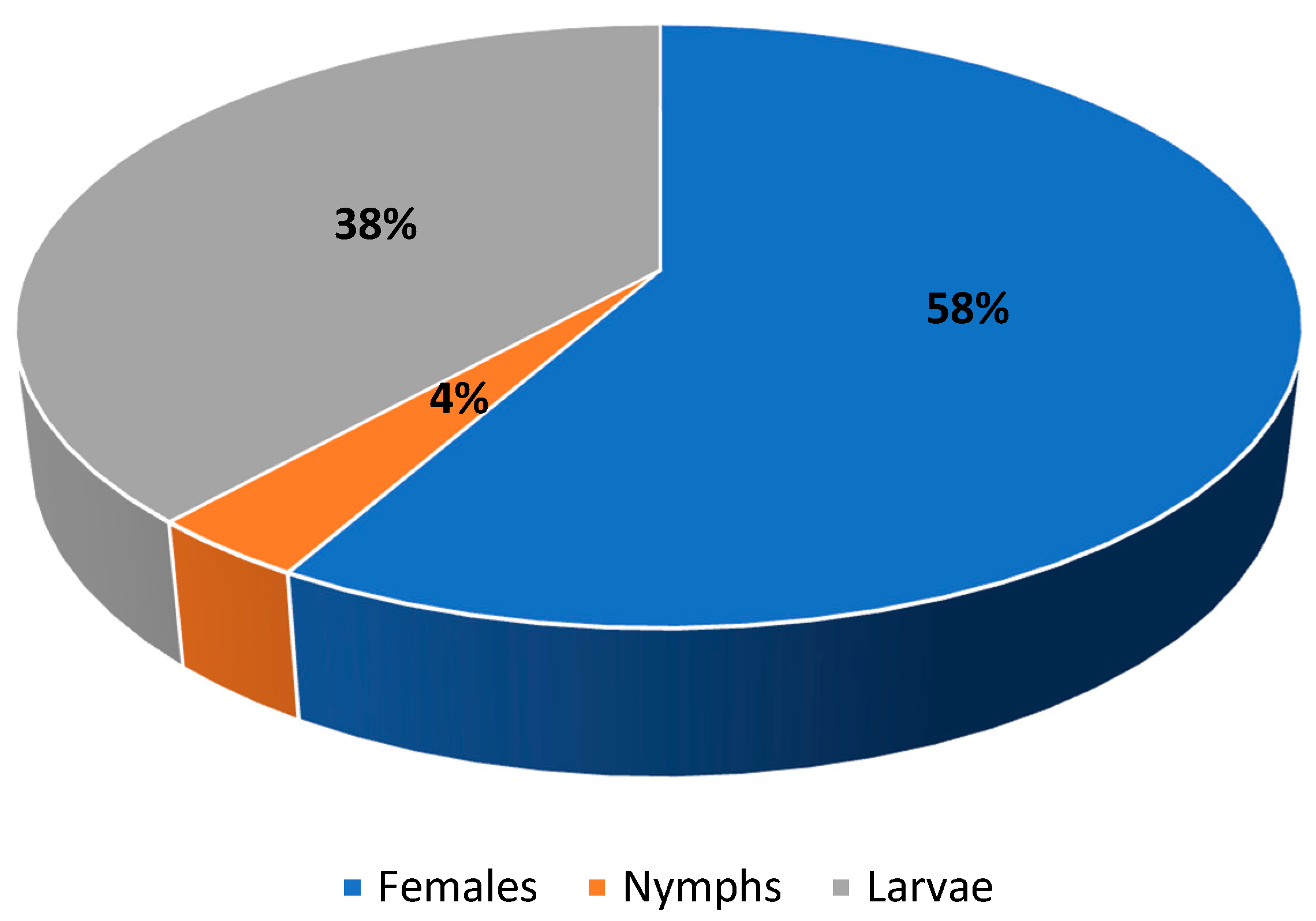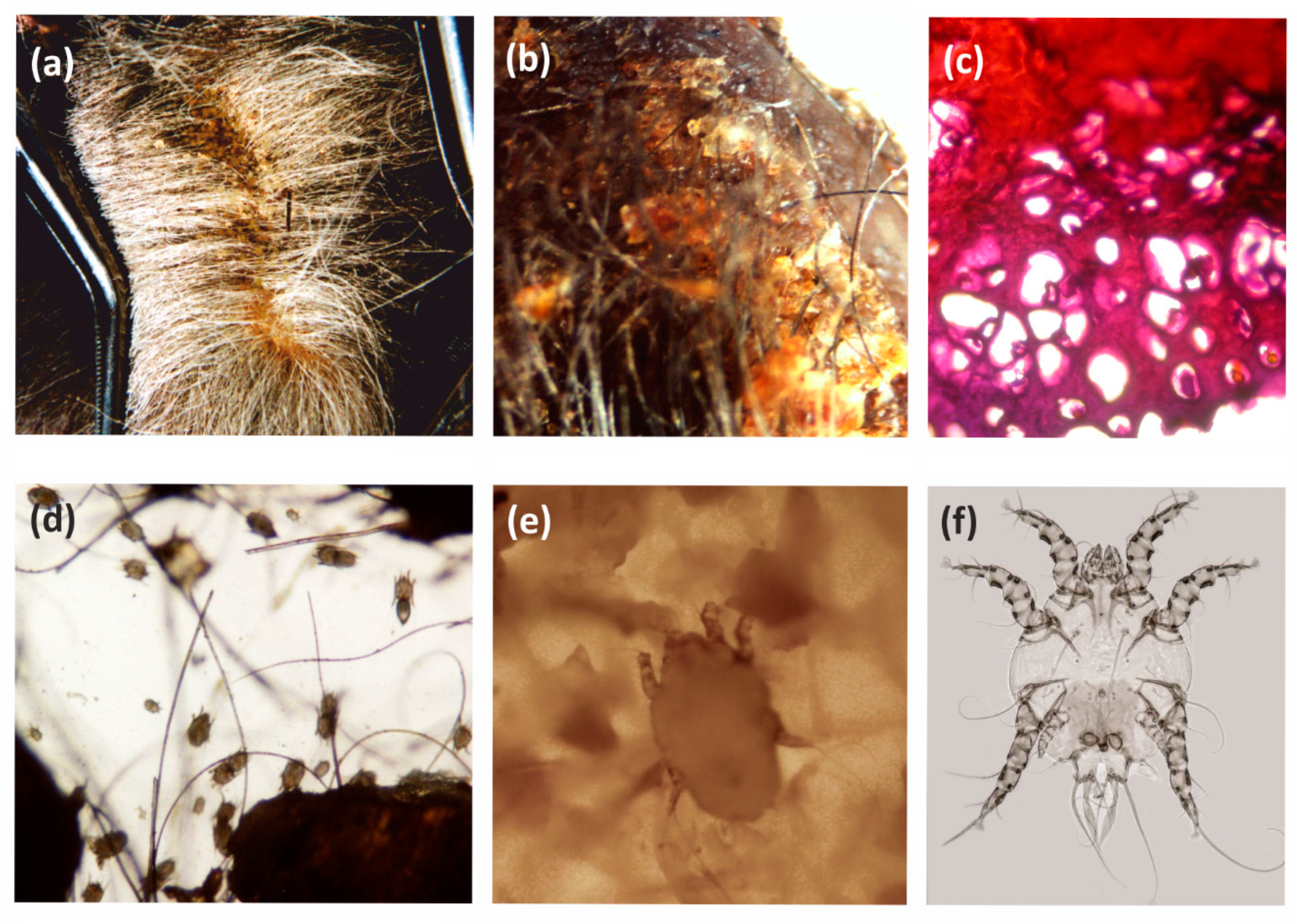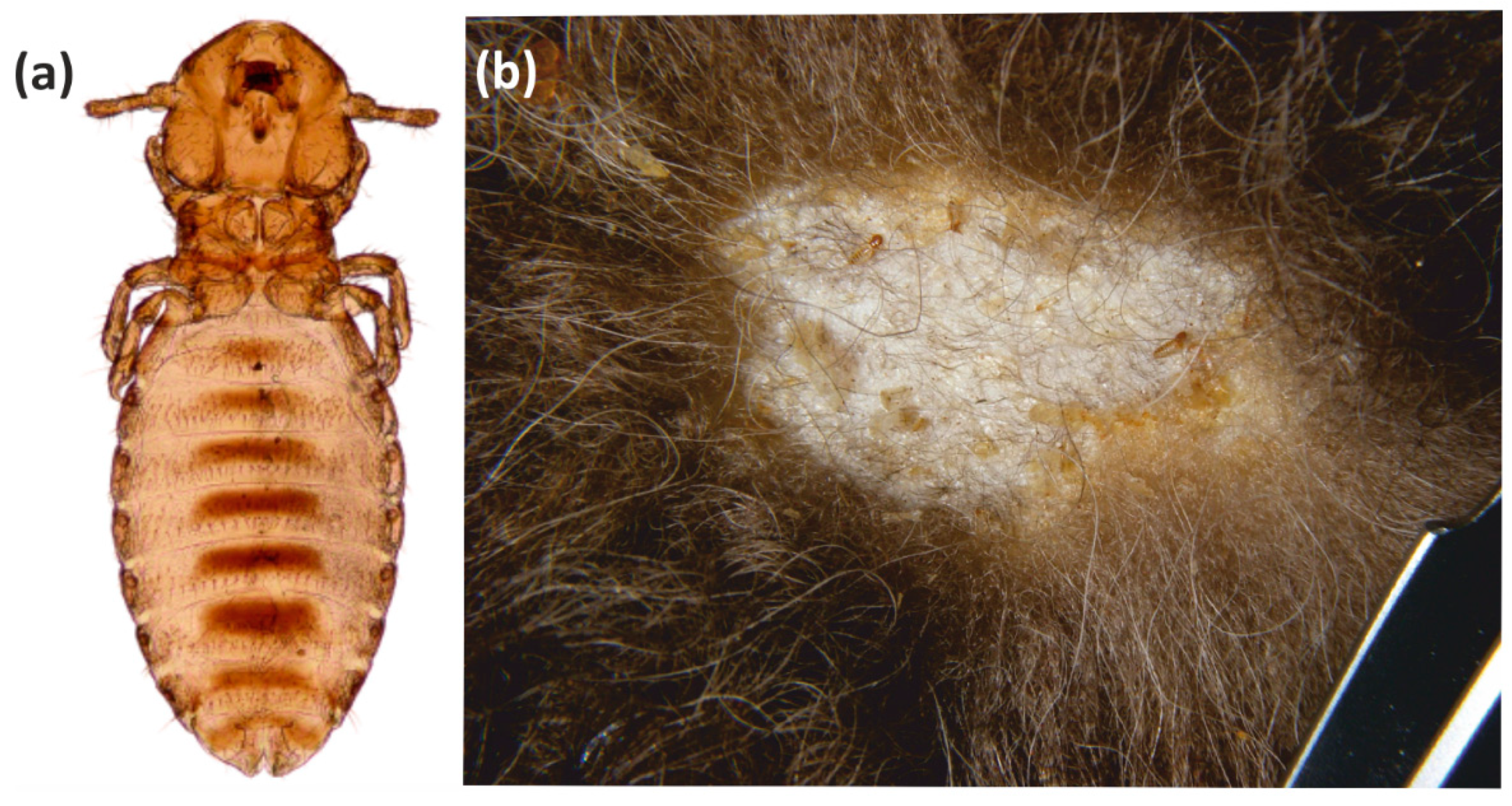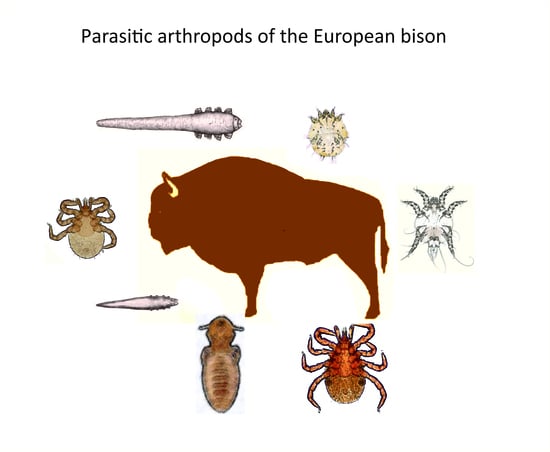The First Data on Parasitic Arthropods of the European Bison in the Summer Season with a World Checklist
Abstract
:1. Introduction
2. Materials and Methods
2.1. Detection of Parasitic Arthropods in Bison bonasus
2.2. The Checklist Structure
3. Results
3.1. Parasitic Arthropods in Bison bonasus in the Summer Season
3.2. Biodiversity of Parasitic Arthropods in Bison bonasus
4. Discussion
4.1. Occurrence of Parasitic Arthropods in the European Bison in the Summer Season
4.2. State of Research on Parasitic Arthropods of the European Bison
5. Conclusions
Author Contributions
Funding
Institutional Review Board Statement
Informed Consent Statement
Data Availability Statement
Conflicts of Interest
References
- Izdebska, J.N. Stawonogi Pasożytnicze Żubra w Świetle Restytucji. In Rola Hodowli Ex Situ w Procesie Restytucji Żubra; Olech, W., Ed.; O. K. L.: Gołuchów, Poland, 2007; pp. 6–11. [Google Scholar]
- Karbowiak, G.; Demiaszkiewicz, A.W.; Pyziel, A.M.; Wita, I.; Moskwa, B.; Werszko, J.; Bien, J.; Gozdzik, K.; Lachowicz, J.; Cabaj, W. The parasitic fauna of the European bison (Bison bonasus) (Linnaeus, 1758) and their impact on the conservation. Part 1. The summarising list of parasites noted. Acta Parasitol. 2014, 59, 363–371. [Google Scholar] [CrossRef] [PubMed]
- Raczyński, J. (Ed.) European Bison Pedigree Book 2020; Białowieża National Park: Białowieża, Poland, 2020. [Google Scholar]
- European Bison Friends Society. Available online: https://smz.waw.pl/baza_wiedzy/mapa-wystepowania-zubra/ (accessed on 17 December 2021).
- Izdebska, J.N. Występowanie Dermacentor reticulatus (Acari, Ixodidae) u żubra (Bison bonasus) z Puszczy Białowieskiej. Prz. Zool. 1998, 42, 219–221. [Google Scholar]
- Izdebska, J.N. European bison arthropod parasites from closed Polish breeding facilities. Acta Parasitol. 2001, 46, 135–137. [Google Scholar]
- Izdebska, J.N. The occurrence of parasitic arthropods in two groups of European bison in the Białowieża Primeval Forest. Wiad. Parazytol. 2001, 47, 801–804. [Google Scholar] [PubMed]
- Izdebska, J.N. Skin mites (Acari: Demodecidae, Psoroptidae and Sarcoptidae) of the European bison, Bison bonasus. Biol. Lett. 2006, 43, 169–174. [Google Scholar]
- Izdebska, J.N. Bisonicola sedecimdecembrii (Phthiraptera: Trichodectidae) from European bison—Redescription of adults and description of juvenile stages. Entomol. Fenn. 2011, 22, 69–77. [Google Scholar] [CrossRef] [Green Version]
- State Forests. Available online: https://www.lasy.gov.pl/en (accessed on 15 December 2021).
- Kadulski, S.; Izdebska, J.N. Methods Used in Studies of Parasitic Arthropods in Mammals. In Arthropods. Epidemiological Importance; Buczek, A., Błaszak, C., Eds.; Kliber: Lublin, Poland, 2006; pp. 113–118. [Google Scholar]
- Izdebska, J.N. Demodex spp. (Acari: Demodecidae) in brown rat (Rodentia: Muridae) in Poland. Wiad. Parazytol. 2004, 50, 333–335. [Google Scholar] [PubMed]
- Klompen, J.S.H. Phylogenetic Relationships in the Mite Family Sarcoptidae (Acari: Astigmata); Miscellaneous publications, No. 180, Museum of Zoology; University of Michigan: Ann Arbor, MI, USA, 1992; pp. 1–154. [Google Scholar]
- Siuda, K. Kleszcze Polski (Acari: Ixodida). Część II. Systematyka i Rozmieszczenie; Polskie Towarzystwo Parazytologiczne: Warszawa, Poland, 1993. [Google Scholar]
- Borowiec, L. Klucze do Oznaczania Owadów Polski. Cz. XXVIII Diptera, z. 77—Wpleszczowate—Hippoboscidae; Państwowe Wydawnictwo Naukowe: Warszawa, Poland, 1984. [Google Scholar]
- Wilson, D.E.; Reeder, D.M. (Eds.) Mammals Species of the World. A Taxonomic and Geographic Reference, 3rd ed.; The Johns Hopkins University Press: Baltimore, MD, USA, 2005; Available online: http://www.departments.bucknell.edu/biology/resources/msw3 (accessed on 15 December 2021).
- Integrated Taxonomic Information System (ITIS). Available online: http://www.itis.gov (accessed on 15 December 2021).
- Margolis, L.; Esch, G.W.; Holmes, J.C.; Kuris, A.M.; Schad, G.A. The use of ecological terms in parasitology (report of an ad hoc committee of the American Society of Parasitologists). J. Parasitol. 1982, 68, 131–133. [Google Scholar] [CrossRef]
- Izdebska, J.N.; Rolbiecki, L.; Bielecki, W. Demodex bialoviensis sp. nov. (Acariformes, Demodecidae) a new, specific parasite of the European bison Bison bonasus (Artiodactyla, Bovidae). Int. J. Parasitol. Parasites Wildl. 2022, 17, 138–143. [Google Scholar] [CrossRef]
- Kadulski, S.; Izdebska, J.N.; Kończyk, M. Stawonogi pasożytnicze żubra Bison bonasus z Puszczy Białowieskiej. Wiad. Parazytol. 1996, 42, 255–260. [Google Scholar]
- Izdebska, J.N.; Rolbiecki, L. Przystosowania do Pasożytnictwa i Lokalizacja Roztoczy Pasożytniczych w Skórze Żubra. In Perspektywy Rozwoju Populacji Żubrów; Olech, W., Ed.; Artisco: Goczałkowice-Zdrój, Poland, 2006; pp. 109–114. [Google Scholar]
- Izdebska, J.N. Obserwacje Lokalizacji Kleszczy (Acari, Ixodidae) u Żubrów (Bison bonasus) w Polsce. In Stawonogi. Interakcje Pasożyt-Żywiciel; Buczek, A., Błaszak, C., Eds.; Liber: Lublin, Poland, 2004; pp. 45–51. [Google Scholar]
- Arzamasov, I. Ixodovye Klešči; Izdatelstvo AN Belaruskiej SSR: Minsk, Belarus, 1961. [Google Scholar]
- Kadulski, S. Pasożyty zewnętrzne żubra Bison bonasus (L.) z Puszczy Białowieskiej. Wiad. Parazytol. 1977, 23, 227–229. [Google Scholar] [PubMed]
- Kadulski, S. Występowanie Stawonogów Pasożytniczych na Łownych Lagomorpha i Artiodactyla—Próba Syntezy; Zeszyty Naukowe Uniwersytetu Gdańskiego. Rozprawy i Monografie: Gdańsk, Poland, 1989; Volume 132, pp. 1–140. [Google Scholar]
- Kiziewicz, B. Zoosporic microorganisms isolated from Dermacentor reticulatus F. ticks found in surface waters of the Białowieża National Park. Pol. J. Environ. Stud. 2005, 14, 691–698. [Google Scholar]
- Karbowiak, K.; Izdebska, J.N.; Czaplińska, U.; Wita, I. Przypadki Zimowania Kleszczy z Rodziny Ixodidae na Żywicielach w Puszczy Białowieskiej. In Stawonogi i Żywiciele; Buczek, A., Błaszak, C., Eds.; Liber: Lublin, Poland, 2003; pp. 77–82. [Google Scholar]
- Matsumoto, K.; Grzeszczuk, A.; Brouqui, P.; Raoult, D. Rickettsia raoultii and Anaplasma phagocytophilum in Dermacentor reticulatus ticks collected from Bialowieza Primeval Forest European bison (Bison bonasus bonasus), Poland. Clin. Microbiol. Infect. 2009, 15 (Suppl. 2), 286–287. [Google Scholar] [CrossRef] [PubMed] [Green Version]
- Mierzejewska, E.J.; Welc-Faleciak, R.; Karbowiak, G.; Kowalec, M.; Behnke, J.M.; Bajer, A. Dominance of Dermacentor reticulatus over Ixodes ricinus (Ixodidae) on livestock, companion animals and wild ruminants in eastern and central Poland. Exp. Appl. Acarol. 2015, 66, 83–101. [Google Scholar] [CrossRef] [Green Version]
- Biernat, B.; Karbowiak, G.; Stańczak, J.; Masny, A.; Werszko, J. The first detection of the tick-borne encephalitis virus (TBEV) RNA in Dermacentor reticulatus ticks collected from the lowland European bison (Bison bonasus bonasus L.). Acta Parasitol. 2016, 61, 130–135. [Google Scholar] [CrossRef] [PubMed]
- Paulauskas, A.; Aleksandravičienė, A.; Lipatova, I.; Griciuvienė, L.; Kibiša, A.; Žukauskienė, J.; Radzijevskaja, J. Molecular detection of Babesia spp. in European bison (Bison bonasus) and their ticks. Ticks Tick Borne Dis. 2021, 12, 101807. [Google Scholar] [CrossRef] [PubMed]
- Izdebska, J.N. Stawonogi pasożytnicze żubrów z Bieszczad. Sci. Messenger Lviv State Acad. Vet. Med. Named S.Z. Gzhytskyj 2001, 3, 208–211. [Google Scholar]
- Kadulski, S.; Izdebska, J.N. Demodex bisonianus sp. nov. (Acari, Demodicidae) a new parasite of the bison (Bison bonasus L.). Wiad. Parazytol. 1996, 42, 103–110. [Google Scholar] [PubMed]
- Izdebska, J.N. Porównanie Infestacji Stawonogami Pasożytniczymi Żubrów ze Stad Wolnych i Hodowli w Polsce. In Ochrona Żubrów Zachodniopomorskich; Olech, W., Ed.; ZODR: Ińsko, Poland, 2005; pp. 38–42. [Google Scholar]
- Demiaszkiewicz, A.W. Przypadek świerzbu naskórnego u żubra Bison bonasus (L) w Puszczy Białowieskiej. Med. Weter. 1988, 44, 547–548. [Google Scholar]
- Izdebska, J.N. Chorioptes Bovis (Acari, Psoroptidae) in Polish Bison: Asymptomatic Infestation? In Proceedings of the Conference European Bison Conservation; Krasińska, M., Daleszczyk, K., Eds.; Mammals Research Institute PAS: Białowieża, Poland, 2004; pp. 54–57. [Google Scholar]
- Izdebska, J.N.; Cydzik, K. Świerzbowiec Naskórny—Rzadki Pasożyt Żubra. In Ochrona Żubrów Zachodniopomorskich; Olech, W., Ed.; ZODR: Barzkowice, Poland, 2005; pp. 43–45. [Google Scholar]
- Izdebska, J.N. Bisonicola sedecimdecembrii (Mallophaga, Trichodectidae)—Wszoł, Który Przetrwał? In Stawonogi i Żywiciele; Buczek, A., Błaszak, C., Eds.; Liber: Lublin, Poland, 2003; pp. 105–115. [Google Scholar]
- Eichler, W. Ein Haarling beim Wisent. Berl. Munch. Tierarztl. Wochenschr. 1946, 44, 3525. [Google Scholar]
- Złotorzycka, J. Klucze do Oznaczania Owadów Polski. Cz. XV, Wszoły—Mallophaga, z. 3—Nadrodziny Goniodoidea i Trichodectoidea; Państwowe Wydawnictwo Naukowe: Warszawa, Poland, 1972. [Google Scholar]
- Wróblewski, K. Żubr Puszczy Białowieskiej: Monografia; Wydawnictwo Polskie: Poznań, Poland, 1927. [Google Scholar]
- Heptner, V.G.; Nasimovich, A.A.; Bannikov, A.G. Mammals of the Soviet Union; Amerind Publishing: New Delhi, India, 1988. [Google Scholar]
- Piusiński, W.; Malicka, E.; Bielecki, W.; Osińska, B.; Lenartowicz-Kubrat, Z. Zmiany patomorfologiczne u żubrów w Puszczy Białowieskiej. Med. Weter. 1996, 52, 386–388. [Google Scholar]
- Piusińiski, W.; Bielecki, W.; Malicka, E.; Kita, J.; Dziąba, K.; Osińska, B.; Anusz, K.; Kowalski, B.; Lenartowicz-Kubrat, Z. Patomorfologia i patogeneza schorzenia narządu płciowego (napletka i prącia) żubrów w Puszczy Białowieskiej. Med. Weter. 1997, 53, 598–600. [Google Scholar]
- Krzysiak, M.K.; Dackiewicz, J.; Kęsik-Maliszewska, J.; Larska, M. Post-mortem evaluation of pathological lesion in European bison (Bison bonasus) in the Białowieża Primeval Forest between 2008 and 2013. Bull. Vet. Inst. Pulawy 2014, 58, 421–431. [Google Scholar] [CrossRef] [Green Version]
- Rzewuska, M.; Rodo, A.; Bielecki, W. Dermacentor reticulatus ticks as pissible vector of Trueperella pyogenes infection in European bison (Bison bonasus): Preliminary studies. J. Comp. Pathol. 2016, 154, 120. [Google Scholar] [CrossRef]
- Izdebska, J.N.; Rolbiecki, L. The Biodiversity of Demodecid Mites (Acariformes: Prostigmata), specific parasites of mammals with a global checklist and a new finding for Demodex sciurinus. Diversity 2020, 12, 261. [Google Scholar] [CrossRef]
- Izdebska, J.N.; Rolbiecki, L. An Analysis of Symptoms of Parasitic Arthropod Infestation on Bison Skin. In Proceedings of the Conference European Bison Conservation; Krasińska, M., Daleszczyk, K., Eds.; Mammals Research Institute PAS, Centre of Excellence BIOTER: Białowieża, Poland, 2004; pp. 58–61. [Google Scholar]
- Izdebska, J.N.; Cydzik, K. Analysis of the reasons for differences in topical specificity among various species of tick (Acari, Ixodidae) infesting European bison. Eur. Bison Conserv. News. 2010, 3, 75–84. [Google Scholar]
- Cayol, C.; Koskela, E.; Mappes, T.; Siukkola, A.; Kallio, E.R. Temporal dynamics of the tick Ixodes ricinus in northern Europe: Epidemiological implications. Parasit. Vectors 2017, 10, 166. [Google Scholar] [CrossRef] [PubMed] [Green Version]
- Lyal, C.H.C. A cladistic analysis and classification of trichodectid mammal lice (Phthiraptera, Ischnocera). Bull. Br. Mus. Nat. Hist. 1985, 51, 187–346. [Google Scholar]
- Schwarz, A.; Maier, W.A.; Kistemann, T.; Kampen, H. Analysis of the distribution of the tick Ixodes ricinus L. (Acari: Ixodidae) in a nature reserve of western Germany using Geographic Information Systems. Int. J. Hyg. Environ. Health 2009, 212, 87–96. [Google Scholar] [CrossRef]
- Gern, L.; Humair, P.F. Ecology of Borrelia burgdorferi sensu lato in Europe. In Lyme Borreliosis: Biology, Epidemiology and Control; Gray, J.S., Kahl, O., Lane, R.S., Stanek, G., Eds.; CAB International: Wallingford, UK, 2002; pp. 141–174. [Google Scholar]
- Nowak-Chmura, M. Fauna Kleszczy (Ixodida) Europy Środkowej; Wydawnictwo Naukowe Uniwersytetu Pedagogicznego: Kraków, Poland, 2013. [Google Scholar]
- Herrmann, C.; Gern, L. Search for blood or water is influenced by Borrelia burgdorferi in Ixodes ricinus. Parasit. Vectors 2015, 8, 6. [Google Scholar] [CrossRef] [Green Version]
- Kadulski, S. Dalsze badania nad stawonogami pasożytniczymi łosia Alces alces w Polsce. Wiad. Parazytol. 1996, 42, 349–355. [Google Scholar]
- Cydzik, K.; Kadulski, S. Parasitic Insects of the Red Deer (Cervus elaphus L.) in the Northern Poland. In Arthropods. Invasions and their Control; Buczek, A., Błaszak, C., Eds.; Akapit: Lublin, Poland, 2009; pp. 59–66. [Google Scholar]
- Adaszek, Ł.; Dzięgiel, B.; Krzysiak, M.; Skrzypczak, M.; Adaszek, M.; Staniec, M.; Wyłupek, D.; Winiarczyk, S. Detection of Borrelia burgdorferi sensu lato DNA in the blood of wild bison from Białowieza Primeval Forest in eastern Poland. Pol. J. Vet. Sci. 2014, 17, 713–715. [Google Scholar] [CrossRef] [PubMed] [Green Version]
- Karbowiak, G.; Víchová, B.; Werszko, J.; Demiaszkiewicz, A.W.; Pyziel, A.M.; Sytykiewicz, H.; Szewczyk, T.; Peťko, B. The infection of reintroduced ruminants—Bison bonasus and Alces alces—with Anaplasma phagocytophilum in northern Poland. Acta Parasitol. 2015, 60, 645–648. [Google Scholar] [CrossRef] [PubMed]
- Didkowska, A.; Klich, D.; Hapanowicz, A.; Orłowska, B.; Gałązka, M.; Rzewuska, M.; Olech, W.; Anusz, K. Pathogens with potential impact on reproduction in captive and free-ranging European bison (Bison bonasus) in Poland—A serological survey. BMC Vet. Res. 2021, 17, 345. [Google Scholar] [CrossRef] [PubMed]
- Jørgensen, D. Conservation implications of parasite co-reintroduction. Conserv. Biol. 2015, 29, 602–604. [Google Scholar] [CrossRef] [PubMed]





| Species | Number of Infected Hosts | Number of Parasites | Prevalence (%) | Mean Intensity | Density 1 (per 1 cm2) |
|---|---|---|---|---|---|
| Ixodes ricinus | 6 | 672 2 | 100.0 | 112 | - |
| Demodex bialoviensis | 2 | 50 3 | 33.3 | - | 1.9 |
| Demodex bisonianus | 6 | 119 3 | 100.0 | - | 2.5 |
| Chorioptes bovis | 5 | 2880 3 | 83.3 | - | 4.8 |
| Psoroptes equi | 1 | 3 3 | 16.7 | - | 0.8 |
| Sarcoptes scabiei | 1 | 1 3 | 16.7 | - | 0.3 |
| Bisonicola sedecimdecembrii | 1 | 6 2 | 16.7 | 6 | - |
| Group | Species | Locality | Remarks | Reference(s) |
|---|---|---|---|---|
| Acari Parasitiformes, Ixodidae | Dermacentor reticulatus (Fabricius, 1794) | Belarus: free-living in Białowieża Forest, Lithuania: free-living and in captivity, Poland: free-living in Białowieża Forest and in captivity (Reserve in Białowieża, Niepołomice, Smardzewice) | Typical parasite (adults) of ungulates, including European bison | [5,6,7,20,21,22,23,24,25,26,27,28,29,30,31] |
| Ixodes hexagonus Leach, 1815 | Poland: in captivity (Niepołomice) | Typical parasite of small mammals, accidentally on the European bison | [6] | |
| Ixodes persulcatus Schulze, 1930 | Poland: free-living in Białowieża Forest and in captivity (Reserve in Białowieża) | Polyxenic, rare on the European bison | [6,7,20,21,22] | |
| Ixodes ricinus (Linnaeus, 1758) | Lithuania: free-living and in captivity, Poland: free-living in Białowieża Forest and Bieszczady Mountains, and in captivity (Reserve in Białowieża, Niepołomice, Smardzewice, zoological gardens) | Polyxenic, typical parasite of the European bison | [6,7,20,21,22,24,25,27,28,31,32], this study | |
| Acari Acariformes Demodecidae | Demodex bialoviensis Izdebska, Rolbiecki et Bielecki, 2022 | Poland: free-living in Białowieża Forest | Specific parasite of the European bison | [19], this study |
| Demodex bisonianus Kadulski et Izdebska, 1996 | Poland: free-living in Białowieża Forest and Bieszczady Mountains, and in captivity (Reserve in Białowieża, Niepołomice, Smardzewice, zoological gardens) | Specific parasite of the European bison | [6,7,8,19,20,21,32,33,34], this study | |
| Demodex bovis Stiles, 1892 | Poland: in captivity (Reserve in Białowieża) | Specific parasite of cattle Bos taurus Linnaeus, 1758; also noted in the Bos taurus indicus Linnaeus, 1758 and accidentally in the European bison | [6] | |
| Acari Acariformes Psoroptidae | Chorioptes bovis (Hering, 1845) | Poland: free-living in Białowieża Forest and Bieszczady Mountains, and in captivity (Reserve in Białowieża, Niepołomice, Smardzewice, zoological gardens) | Typical parasite of ungulates | [6,7,8,20,21,32,35,36], this study |
| Psoroptes equi 1 (Hering, 1838) | Poland: free-living in Białowieża Forest and in captivity (Reserve in Białowieża) | Typical parasite of ungulates, rare in the European bison | [6,7,8,20,21,37], this study | |
| Acari Acariformes Sarcoptidae | Sarcoptes scabiei (De Geer, 1778) | Poland: free-living in Białowieża Forest and in captivity (Reserve in Białowieża) | Polixenic mammalian parasite, rare in the European bison | [7,8,21], this study |
| Insecta Pthiraptera, Trichodectidae | Bisonicola sedecimdecebrii (Eichler, 1946) | Europe, Poland: free-living in Białowieża Forest and Bieszczady Mountains, and in captivity (Reserve in Białowieża, Niepołomice, Smardzewice, zoological gardens) | Specific parasite of European bison | [6,7,9,20,24,25,32,38,39,40], this study |
| Insecta Pthiraptera, Haematopinidae | Haematopinus eurysternus (Nitasch, 1818) | Poland: Białowieża Forest | Specific parasite of cattle, found only once on the European bison | [41] |
| Insecta Diptera, Hippoboscidae | Hippobosca equina Linnaeus, 1758 | Poland: free-living in Białowieża Forest | Typical parasite of ungulates, accidentally on the European bison | [25] |
| Lipoptena cervi Linnaeus, 1758 | Poland: free-living in Białowieża Forest and in captivity (Reserve in Białowieża, Niepołomice), Ukrainian (Crimean Reserve) | Typical parasite of cervids, noted sporadically on European bison | [6,7,20,24,25,42] | |
| Melophagus ovinus (Linnaeus, 1758) | Poland: in captivity (Reserve in Białowieża) | Sheep-specific parasite, accidentally on the European bison | [6] |
Publisher’s Note: MDPI stays neutral with regard to jurisdictional claims in published maps and institutional affiliations. |
© 2022 by the authors. Licensee MDPI, Basel, Switzerland. This article is an open access article distributed under the terms and conditions of the Creative Commons Attribution (CC BY) license (https://creativecommons.org/licenses/by/4.0/).
Share and Cite
Izdebska, J.N.; Rolbiecki, L.; Bielecki, W. The First Data on Parasitic Arthropods of the European Bison in the Summer Season with a World Checklist. Diversity 2022, 14, 75. https://doi.org/10.3390/d14020075
Izdebska JN, Rolbiecki L, Bielecki W. The First Data on Parasitic Arthropods of the European Bison in the Summer Season with a World Checklist. Diversity. 2022; 14(2):75. https://doi.org/10.3390/d14020075
Chicago/Turabian StyleIzdebska, Joanna N., Leszek Rolbiecki, and Wojciech Bielecki. 2022. "The First Data on Parasitic Arthropods of the European Bison in the Summer Season with a World Checklist" Diversity 14, no. 2: 75. https://doi.org/10.3390/d14020075
APA StyleIzdebska, J. N., Rolbiecki, L., & Bielecki, W. (2022). The First Data on Parasitic Arthropods of the European Bison in the Summer Season with a World Checklist. Diversity, 14(2), 75. https://doi.org/10.3390/d14020075









